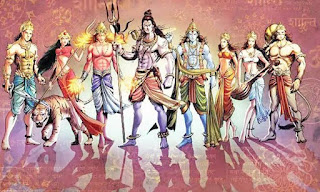Hindu Mythology
. ABOUT INDIAN FOLKLORE
Presentation
Indian religion and folklore are intently interlaced and can't exactly be isolated. In addition, both are so immense and confounded that any speculation is probably going to misrepresent. The earliest Indian texts are the Vedas, a progression of sacrosanct songs to pay tribute to the Aryan divine beings, who exemplified regular powers like the sun, storm, fire, soma, and so forth. The Vedic religion was materialistic, committed to getting power, flourishing, wellbeing, and different endowments through custom and penance.
When of Buddha around 500 B.C., the old Vedic religion had been changed by Brahmin ministers into a fantastical mishmash, with the clerics guaranteeing exceptional powers for themselves. Buddha addressed himself to the issue of human misery and found a method for killing it through focused living and surrendering one's cravings. He acquired such countless devotees that the Brahmins had to integrate his thoughts into their lessons. The outcome was Hinduism, a changed polytheism with three significant divine beings: Brahma, Vishnu, and Siva.
We will take a gander at the foremost Vedic and Hindu divine beings and relate two proper fantasies. Then we will see two legends, the primary getting from the Ramayana and the second treating the existence of Buddha.
Principal Vedic Divine beings
Indra is the fundamental lord of the Vedas, a hard-drinking, strutting champion who rides his sun powered chariot across the sky and uses the thunderclap. As a tempest god he carries the downpour to prepare India's dry soil.
Mitra and Varuna keep the infinite control. Mitra, the sun, manages agreements and kinship, while Varuna, the moon, regulates pledges. Like Indra, these divine beings mirror the upsides of the hero station.
Agni is the minister's lord of fire. He manages at the raised area and hearth, exists as lightning, and bursts at the core of the sun.
Brihaspati is the divine force of chant and custom, the exemplification of clerical wizardry.
Soma is both an opiate plant and a divine being who gives motivation, frees men, and addresses the guideline of life.
Savitar is the lord of movement, and anything moves or acts is subject to this god with brilliant eyes, hands, and tongues.
Ushas is the lovely, beguiling goddess of the day break, a wellspring of pleasure to every living animal.
Puchan brings everything into relationship, favoring marriage, giving food, directing explorers, and guiding the dead.
Siva is the unnerving divine force of obliteration, a god so impressive that individuals should compliment him to deflect disaster.
Kali is Siva's better half, a murderous fruitfulness goddess designed with seals of death.
Prajapati is the expert of made creatures, the dad of divine beings and evil presences, and the defender of the individuals who multiply.
The Devas and Asuras are divine beings and evil presences, individually, and fight each other with enchanted powers.
The Rakshas are abhorrent semi-divine animals that training dark sorcery and distress men with disaster.
Hindu Divine beings and Ideas
Brahma alludes to the profound reality hidden all peculiarities, and is once in a while represented as a divine being. Brahma arose out of the brilliant egg made by the waters of confusion and laid out each universe.
Maya is the cloak of deception, the erotic appearances that trick individuals into realism.
The Immigration of Spirits alludes to the penchant of spirits to manifest themselves in different material structures, from the mineral to the godlike. Since soul matter is indestructible, every spirit carries on with countless lives.
Karma alludes to the obligation of wrongdoing caused previously and in this current life, an obligation that should be paid before the spirit is to arrive at flawlessness.
Vishnu is the incomparable Hindu god. He lays on the grandiose waters between manifestations, or universes; and in every creation he takes on some symbol or material structure like a fish, a wild pig, a turtle, a lion, a smaller person, a man. His love is set apart by warm devotion and commitment.
Siva is a critical Hindu god, the moving divinity of creation and obliteration. He has four arms and has a third eye on his temple with which he obliterates. His love is set apart by plainness.
Parvati is Siva's significant other, a goddess emblematic of his power and heartless in her fights against evil presences under her different names and viewpoints.
Ganesa is the well known lord of thriving, a child of Siva and Parvati with four arms and an elephant's head.



Comments
Post a Comment